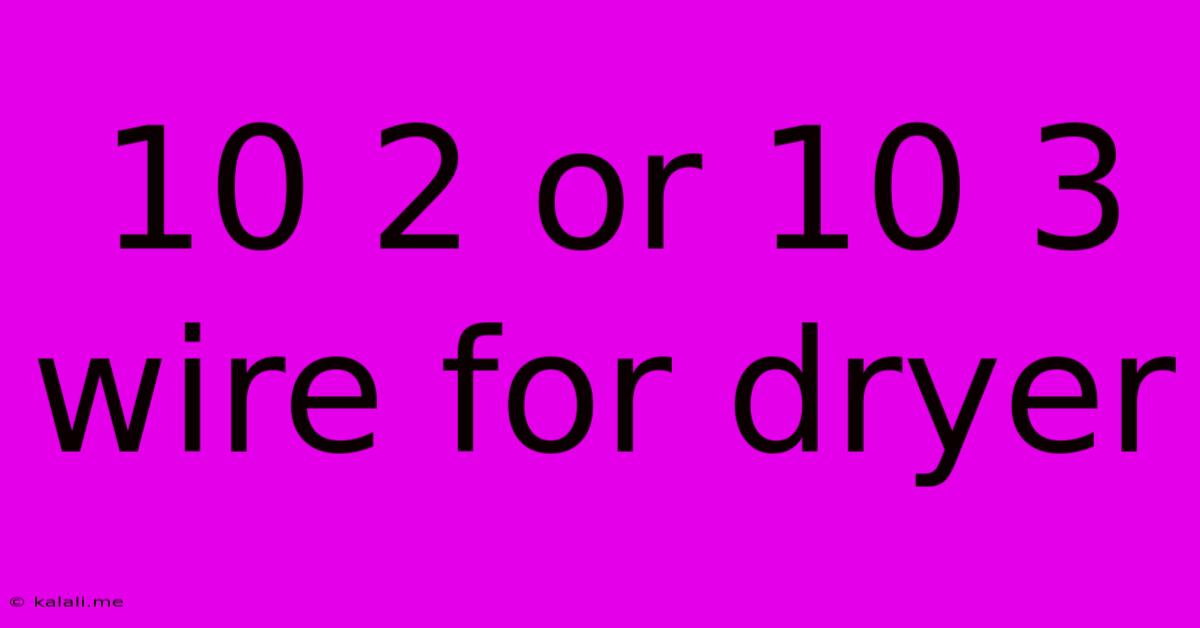10 2 Or 10 3 Wire For Dryer
Kalali
May 25, 2025 · 3 min read

Table of Contents
10-2 vs 10-3 Wire for Your Dryer: Which One Do You Need?
Choosing the right wiring for your dryer is crucial for safety and proper functionality. This article will clarify the differences between 10-2 and 10-3 wire, helping you determine which one is appropriate for your dryer installation. Understanding the voltage requirements and amperage capacity is key to a successful and safe connection.
What's the Difference?
The numbers "10-2" and "10-3" refer to the gauge and number of wires within the cable. The "10" indicates the wire gauge – a measure of thickness, with lower numbers representing thicker wires capable of carrying more current. The "2" and "3" represent the number of conductors (wires) in the cable.
- 10-2 wire: Contains two hot wires, one neutral wire, and a ground wire. This is typically used for 240-volt appliances that don't require a separate neutral wire for the heating element.
- 10-3 wire: Contains three hot wires, one neutral wire, and a ground wire. This configuration is necessary for 240-volt appliances that need a dedicated neutral wire for specific functions, like a motor or electronic controls. Some dryers utilize this setup.
Why the Difference Matters: Understanding Your Dryer's Needs
Most modern electric dryers operate on 240 volts. However, the internal circuitry and heating element configuration will dictate the necessary wiring type. Older dryers might use a simpler 10-2 setup, while newer models with more advanced features or higher power demands often require the 10-3 configuration. Always consult your dryer's installation manual to definitively identify the correct wiring requirements. The manual will typically specify the voltage, amperage, and wiring type needed for safe and efficient operation. This information is crucial to avoid electrical hazards and ensure the longevity of your appliance. Incorrect wiring can lead to malfunction, fire hazards, or even electric shock.
Identifying Your Dryer's Requirements
Before you begin any wiring work, always turn off the power at the breaker box. This is a crucial safety step to prevent electrical shocks and injuries. Once the power is safely off, locate the dryer's data plate. This plate usually contains information about the voltage, amperage, and wiring requirements.
Beyond the Wire: Other Important Considerations
- Amperage: While wire gauge is important, you also need to check the amperage rating of your dryer and ensure your electrical circuit can handle the load. This information is typically found on the data plate as well. An insufficient amperage can overload the circuit and cause tripping breakers or even a fire hazard.
- Circuit Breaker: Ensure the breaker in your electrical panel matches the dryer's amperage rating. A 30-amp breaker is common for many dryers, but check your dryer's specifications.
- Professional Installation: Unless you are experienced with electrical work, it's strongly recommended to hire a qualified electrician to install your dryer. Incorrect wiring poses significant safety risks.
Conclusion:
Choosing between 10-2 and 10-3 wire for your dryer hinges on your specific appliance's requirements. Always consult your dryer's installation manual for definitive instructions and specifications. Prioritizing safety and ensuring correct wiring is crucial for preventing electrical hazards and ensuring your dryer operates correctly. If you're unsure, it is always better to consult with a qualified electrician. They possess the expertise and knowledge to perform the work safely and accurately. Don't compromise safety for convenience.
Latest Posts
Latest Posts
-
Origin Of Thrown Under The Bus
May 25, 2025
-
What Makes A Pixel More Important In A Cnn
May 25, 2025
-
Does A Pb And J Sandwich Need To Be Refrigerated
May 25, 2025
-
What Does Ot Mean In Texting
May 25, 2025
-
How Long Will Tuna Salad Last In Fridge
May 25, 2025
Related Post
Thank you for visiting our website which covers about 10 2 Or 10 3 Wire For Dryer . We hope the information provided has been useful to you. Feel free to contact us if you have any questions or need further assistance. See you next time and don't miss to bookmark.